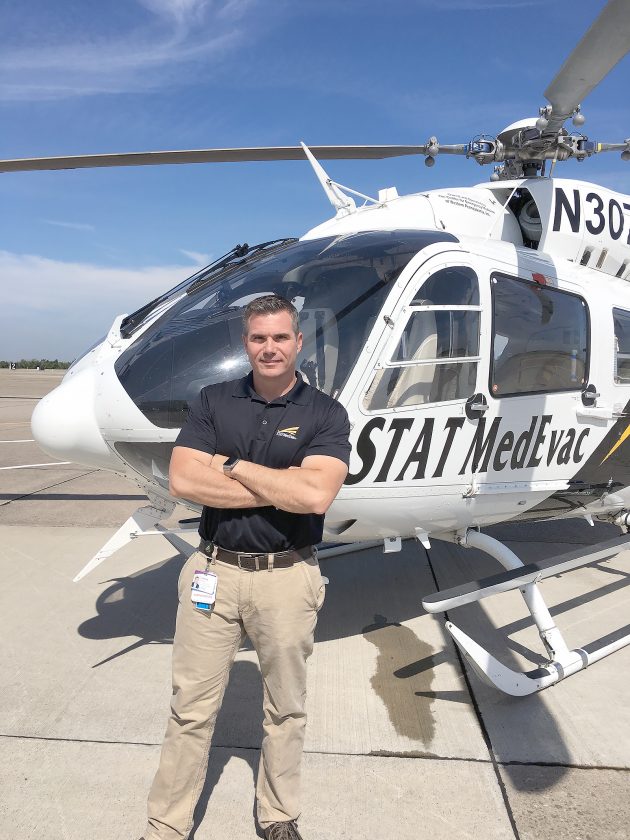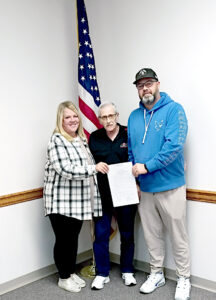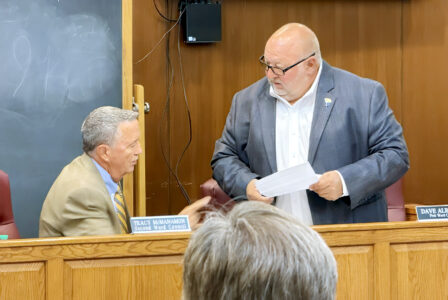Local man named president of UPMC Center for Emergency Medicine

SETTLING IN — Steubenville resident James R. “Jim” Houser is settling in to his new role, having been appointed by UPMC to be the president and CEO of the Center for Emergency Medicine of Western Pennsylvania, which focuses on prehospital care and paramedic services. Houser will run the critical care air ambulance service, STAT MedEvac. -- Contributed
STEUBENVILLE — James R. “Jim” Houser of Steubenville has a new title after his name, having recently been appointed as UPMC’s president and CEO of the Center for Emergency Medicine of Western Pennsylvania, which also operates the region’s STAT MedEvac critical care air ambulance service.
And that music-to-medical journey for the 1997 graduate of Indian Creek High School has a connect-the-dots sort of story feel to it.
The son of Jim Houser of Wintersville and the late Lynn Houser has been settling into the position since Nov. 1, a role with familiarity but new learning opportunities and challenges, including a precautionary safety response to the COVID-19 pandemic.
The Center for Emergency Medicine of Western Pennsylvania Inc., an independent 501(c)3 (Type 1) organization founded Nov. 1, 1978, is dedicated to improving emergency medical and prehospital care. CEM is comprised of a consortium of hospitals operated by UPMC, including UPMC Presbyterian Shadyside, UPMC Altoona, UPMC Hamot, UPMC Mercy and Children’s Hospital of Pittsburgh of UPMC. The organization has four divisions and employs more than 400 clinicians, educators and researchers throughout Pennsylvania, Ohio, Maryland, New York and Washington, D.C.
STAT MedEvac, a critical care transport system, is the clinical arm of CEM and is one of the largest single operated and dispatched air-medical transport systems in the United States. STAT MedEvac operates 18 helicopter base sites in Pennsylvania and surrounding states, including in Wintersville at the Geary A. Bates Jefferson County Airport.
Houser joined CEM in 2016, serving most recently as senior director, medical operations and chief clinical officer. Before joining UPMC, he served as vice president at MedFlight in Columbus.
“Jim brings over 20 years of industry experience and a diverse background in the field of critical care transport to this role,” said John Innocenti, president, UPMC Presbyterian and Shadyside, in an announcement on UPMC’s website. “His dedication and commitment make him the ideal leader to enhance the CEM’s reputation as a world leader in emergency medicine care, education and research.”
That this would be his vocation was nowhere on Houser’s radar as a teenager, envisioning himself as a trumpet player.
“I didn’t have the best direction, but what I did have was a passion for music, and I could play the trumpet pretty well,” Houser said. “Like every kid, I probably had aspirations of being a professional musician, you know, just like a professional athlete.”
A turning point changed that school of thought, though.
“I quickly learned that you couldn’t do these things on talent alone. I had to figure out my plan for school. In fact, I was fairly along in the process of entertaining the idea of enrolling in the Army, which was recruiting me to be in the Army Band,” he said.
Houser completed the physical, but then realized a music career would probably involve being an educator.
“As a kid, I didn’t really like the idea of teaching, which now it’s funny because I enjoy teaching,” he said. “How that connects me to where I am today is actually very relevant.”
After graduation, Houser worked at multiple jobs, including at Giannamore’s Pizza. “I don’t think I’ve had less than two W-2s my entire life,” he said with a laugh.
The late Kevin Sczruba, a good friend who would greatly influence what direction Houser’s life would take, wanted to rejoin the Wintersville Fire Department as a volunteer and asked Houser if he was interested to come on board as a newbie.
He was.
“When I was in junior high, I was in the Boy Scouts with a couple of kids who were junior volunteer firefighters with the Wintersville Fire Department, and because they were active, and I liked the idea of what they were doing, I wanted to do it in the worst way, but my parents did not have any interest in driving me to the fire department, so they pretty much shut this idea down. Like many things as a junior high kid that interest came and went,” Houser said.
But in the summer of 1997, it returned. Sczruba and Houser got voted in.
“I started volunteering with them, and they’re a volunteer fire and EMS service,” he explained during his looking-back interview Tuesday. “They do firefighting and there’s a lot of excitement in firefighting. People get wrapped up in the notion of going into a burning building and trying to combat active fire.
“I found it very interesting taking care of patients,” commented Houser, who grew up on Bantam Ridge Road in Wintersville.
“The connection for me as an 18-year-old kid trying to figure out what he wanted to do with his life is I found a similar passion. I felt the same comfort with taking care of people in the back of the ambulance in that environment as I did playing music, enjoying what I did when I was playing with the band and playing my trumpet,” he said.
“Something felt natural and comfortable.”
But there was a tricky part about all this — how would such volunteer work ever translate into a paycheck?
Spur of the moment, Houser reached out to the former Jefferson Community College about hopping into an EMT class. “It was not something that I’d planned,” Houser said. “I didn’t really know what an EMT was before Kevin introduced me to the fire department, let alone planning on hopping into an EMT program that very same fall semester.”
Houser became a certified EMT, continued volunteering with the fire department and with his certification, took a job with Ambulance Service Inc. in Steubenville.
“At the time there were still some requirements as to how long you had to be an EMT before you could go into a paramedic program,” he said in explaining how he asked for a waiver and ended up this time around being accepted into the paramedic program at the community college.
That pursuit would fuel banter between Houser and his mother. “She was a nurse and always made sure I knew that,” he said, adding, “I would confidently push back that I was a paramedic.” She ultimately got the last laugh, according to Houser, who would later complete studies to become a nurse, earning his associate’s degree, then bachelor’s and master’s degrees, then becoming a nurse practitioner.
Houser said he plowed full steam ahead with paramedic studies. “I liked taking care of patients so I quickly am moving from being an EMT to an EMT intermediate as I went through the program to becoming a paramedic. I still have people asking, though, what are you going to do? How are you going to turn this into a career, and I wasn’t quite sure. I hadn’t quite thought that through,” he said.
A wreck on Coal Hill Road put his future more into focus.
“I remember like it was yesterday. We had a vehicle accident that had a badly injured patient — a trauma patient that we had responded to in the middle of the night with the Wintersville Fire Department,” he said. “We took care of the patient, and Rob Herrington, who I would say is another influence on my career, identified pretty quickly that this patient was probably going to need to be transported to a trauma center, the first kind of incident I was involved in.
“I really didn’t connect everything that was going on at the time — I’m new, young and this is my first really hectic call — so I didn’t quite understand what was going on in the background, but I’ll never forget, as we pulled into the ER bay at Trinity West, hearing the helicopter land outside of the emergency department, and realizing that that crew was there to take care of our patient, and I just watched that whole scene unfold, and it was at that moment, I’m like, that’s what I want to do with my life,” he said.
“That was to me the hook in turning this thing that I found resonated with me, like music, but medicine. That kind of introduced me to STAT MedEvac that landed that night so I saw that crew come in. It was MedEvac 1 out of Washington, Pa. That’s what introduced me to what I do today.”
He continued working at ASI, intent on gaining experience and contemplating “the next odd transition” as one being young and newly married. He and his wife, Sarah, were new parents to daughter Madison, now 20 and a student at Ohio State University. Son Marshal is 14, an eighth-grader at Indian Creek Middle School.
Houser thought going to nursing school would be the next best move for him and his family, but that would be delayed. His wife, now a geometry teacher at ICHS whom he describes as his true partner in life’s adventures, was finishing schooling for her teaching degree.
“I ended up leaving ASI and took a job at Mercy Hospital in Pittsburgh, working night shifts as an ER tech and a lure to that were two things — the schedule and the fact that I could work at a level one trauma center and kind of introduce myself to this bigger hospital experience,” he said.
Working in an organization like STAT MedEvac or any of the critical care helicopter transport programs, requires experience, Houser pointed out. Most require several years and scrutinize a resume.
“It’s a fairly competitive position to try to attain, flying a helicopter,” Houser said, noting he had applied and gotten a rejection letter because he didn’t meet the qualifications and needed experience.
Coming home after a night shift at Mercy, Houser recalled there was a message on his answering machine.
“All I heard was STAT MedEvac and interview,” he said. “I still to this day I don’t know how they connected this or how I ended up on this list, but I had applied to fly as a flight paramedic, and I got a call from them to interview in their communication center. It was not what I was initially looking to do, but here’s the cool thing about how all these things align for me,” he said.
In retrospect, Houser recalls some advice and encouragement, including from the late Tom Mayers, a flight crew member who directed him to persevere, “to keep applying and doing what you’re doing.” Another co-worker had noted the communications route wasn’t the normal pathway to being a fight paramedic, “but you never know – get your foot in the door.”
In the fall of 2001, Houser was working in the communication center at STAT MedEvac, intent on doing the best job he could.
“The cool thing is I grew up right about this time, whether it was STAT MedEvac that helped me grow up, whether it was being a new father, I can’t think of what occurred, but I went from a guy that was late, always had to push myself out of bed, to the guy that was 20 to 30 minutes early every shift, always making sure that every ‘I’ was dotted, every ‘T’ was crossed, that I was doing the best work that I could possibly do, because I knew, that was the only way that I was going to continue to move ahead and get the opportunity to fly,” Houser said.
“It was cool because now I’m working for the organization, I’m seeing these job postings, and at the same time. I’m really finding that I enjoy the work that we do in the communication center, and I gained a tremendous amount of respect for that team and what what they do,” he said.
“Our communication center is the first point of contact that anyone has with the type of crazy stuff that we do, the care that we provide, the innovative medicine, all those things that we do, do not get to those patients without that communication center, and I learned that firsthand up there. They’re the ones that facilitate everything in the background,” he said.
“I really started to enjoy that, but at the same time, I wanted to be out there, flying on the line, taking care of the patients in the helicopter. I’m watching these postings and like any job, there’s a certain window where you’re eligible to apply so I knew I had to wait at least six months, and during that six months, again, it gave me a chance to get to know people. I made friends, learned all these different things about how important the communication center is and then the six months came and passed, and I had a chance to apply for a flight position,” he said.
And that brought Houser what he said was his first hard lesson in career progression.
“I was told by the manager. I can’t support you applying right now. You’re doing too good a job in here. We need you in the communication center,” Houser recalled the explanation, going home that day “completely deflated” and in need of a self-pep talk.
“I said you know this is your make-or-break move. You can get all upset and have a bad attitude or you can get up tomorrow and continue to do what you did yesterday and hope things work out,” he said.
“Three months later, that manager left, and one of our supervisors took that position who worked with me and understood my job passion,” he continued. “Not only did he support me, but he put in a good word and ended up helping facilitate me getting an interview, which ultimately got me the chance to transition to flying as a flight paramedic.”
Houser was offered a casual flight paramedic position at the base in Connellsville, Pa., MedEvac 5.
“I had to go home and tell my wife that I’m given this opportunity, but that means I have to quit my full-time job with the same organization to basically move to a casual position,” he said, noting his wife is in school full time at this point and the couple have a toddler.
“I’m so fortunate my wife has always supported me, and I don’t want to say that she was enthusiastic about the idea of me not having benefits, but she was enthusiastic about the idea that we would figure it out,” Houser said. “Her support has played a big role in my success and more importantly, recovering from my failures,” he added.
“I had to start applying for other positions, because I was going to have to obviously continue to work full time because she was in school finishing her teaching degree,” he said, noting a friend suggested Baldwin EMS, which brought a lot of patients to Mercy. He applied and was offered a position, working full time as a municipal rescue technician/paramedic for a suburb of Pittsburgh while also flying as a flight paramedic at STAT MedEvac.
During that time, Houser remembers being asked to do a child day at Carnegie Science Center, which involved teaching, for instance, the basic concept of CPR. “I loved teaching and educating about what we do at STAT MedEvac,” he said of what resonated with him and began a connection with the marketing team.
“The next thing you know, I’m taking a full-time job with STAT MedEvac where I flew clinically 50 percent of the time as a flight paramedic and then I was out doing marketing and business development on the outreach team, going around and trying to educate the community on what we do, foster new business and build relationships,” he said.
It was around 2006 Houser started doing more business development, working on some higher level types of relationship building and contracts with some larger health systems. Next came more involvement in operational discussions, a new experience.
“Everything I had done to this point was either direct clinical care, direct frontline work or business development,” he said. “I started thinking about what opportunities I had here at STAT MedEvac and about the same time, we had a transition of locations in Eastern Ohio in the New Philadelphia area, and I had established a rapport with some of our competitive colleagues in Columbus, a group called MedFlight, which is an Ohio State Ohio Health Consortium.”
It would lead to Houser becoming base director for MedFlight’s operation in New Philadelphia, a job he held for two years before being recruited back to STAT MedEvac as special projects manager, working with the business development team.
“So I left my colleagues in Columbus, which was tough because I established a great relationship with those folks and came back here to Pittsburgh, and I ended up working in a special project role for about a year, and then I was promoted to oversee the entire business relations and development.”
Houser would return again to MedFlight in Columbus to a regional operations role, then vice president of clinical operations for the organization.
“Things were actually going pretty great — I’m in this new role, we had made some leadership changes and had just worked through some tough times and really just seemed like we were clicking on all cylinders,” Houser said. “At the same time, I was settling into my role over there, two individuals from STAT MedEvac had left and my boss at the time was using that opportunity to change a legacy leadership structure at STAT MedEvac.”
Houser returned to STAT MedEvac as the senior director of medical operations and chief clinical officer for STAT MedEvac. “I’ve been back here since 2016 and held that role, overseeing all of the medical operations for the entire organization,” he said.
Houser did that until Nov. 1, when he was offered his current position.
“My colleagues at MedFlight, whom I am still close with, had a lot of good laughs about my last departure,” Houser noted. “I still have the boomerang they gave me in my office. They are great people and many are good friends to this day. That said, I have a habit of prefacing my back and forth with a bit of awkwardness, but the reality is it was never for the same role or negotiating a new pay rate. Each move was for something new. Something I wanted to learn or something I wanted to be challenged by,” he explained.
House sings the praises of CEM.
“I love what we do and am extremely proud of the men and woman I work alongside,” he said. “They do amazing work — coordinating complex transports; determining if you can fly on a major airline or what help you need at 30,000 feet; getting our talented transport crews to the sickest of patients at 0300 in the morning; our exceptional team of pilots, mechanics and support staff, who get our crews to these patients; our critical care ground and helicopter teams who change people’s lives every day; our physicians who are paving the way for future EMS providers with their repeated groundbreaking research and leadership; and our educators who work tirelessly to have the latest content, methods and teaching to assure we have the best providers for the future.”
Houser explained that the Center for Emergency Medicine was founded Nov. 1, 1978. “It was started under the auspice of developing education for both field providers and emergency physicians, and so it started as a consortium organization in Pittsburgh that over time, that consortium grew to be fully represented by UPMC and that’s why we’re now the business unit of UPMC,” he continued.
“But our roots are really founded in education. We still support UPMC and Pitt with their emergency medicine residency program. We coordinate both a community paramedic program, and we have a partnership with the University of Pittsburgh to provide a four-year bachelor’s degree in emergency medicine, where you can become a paramedic and get your bachelor’s degree in emergency medicine, so it’s a more formalized degree,” he said.
“And just as important, but probably not readily known by the public, the Center for Emergency Medicine really was instrumental in the development of our modern EMS delivery system, so our team literally wrote the standards that paramedics are taught today to represent those standards in various ways with sitting on national boards and ensuring that there’s quality education being provided to paramedics across the country,” Houser said.
“That’s a really big part of what we do that probably isn’t as well known but it’s part of the center, our overarching organization,” he continued. “And then within that you have STAT MedEvac, which is probably the most widely known part of the organization because of its size and just because of what we do and it’s the most prevalent out in the community, ” he continued.
“We also provide online medical command and patient screening for several of the world’s largest airlines, so when you hear of an inflight emergency, and a 737 has to divert or a pair of passengers being resuscitated in the back of a passenger plane, our teams are the ones that are providing that guidance and support to whoever’s on the other end of the radio and then also making the decision in coordination with the captain of the airplane as to them and when they have to divert.”
Houser said he is happy in his new position. “I’ve got a lot to learn and I’m still definitely getting settled, but I’ve got a good group that’s helping me do that.”
His advice to seniors who might not know what they want to do for a living?
“Take a deep breath, think about where you want to be, know that that might change, and be open minded to those changes, and just continue to have a positive attitude, Houser offered, noting if he were able to go back and talk to himself as a freshman, he’d say study and be prepared for every test.
Busy as he is, Houser finds time to work a couple hours a week or month in the emergency room at Trinity Medical Center West as a nurse practitioner.
And that means some things don’t change. “As I mentioned at the very beginning, I don’t think there’s been a time in my life where I’ve had less than two W-2s.”
(Kiaski can be contacted at jkiaski@heraldstaronline.com.)



